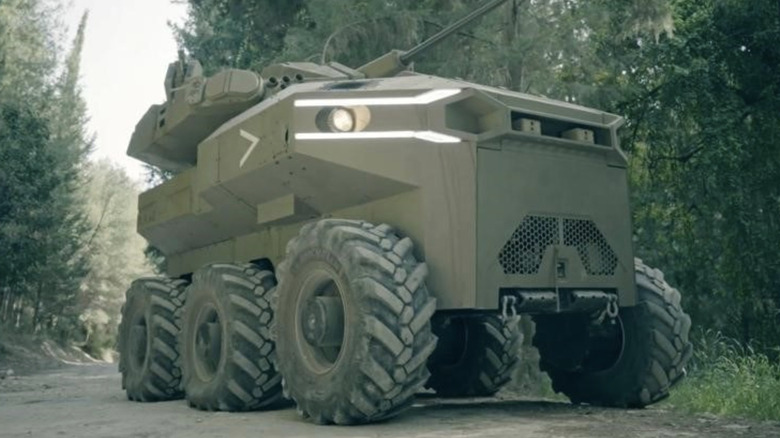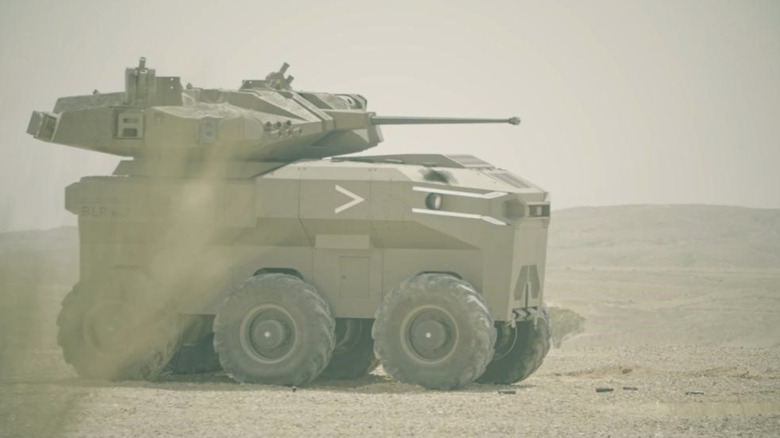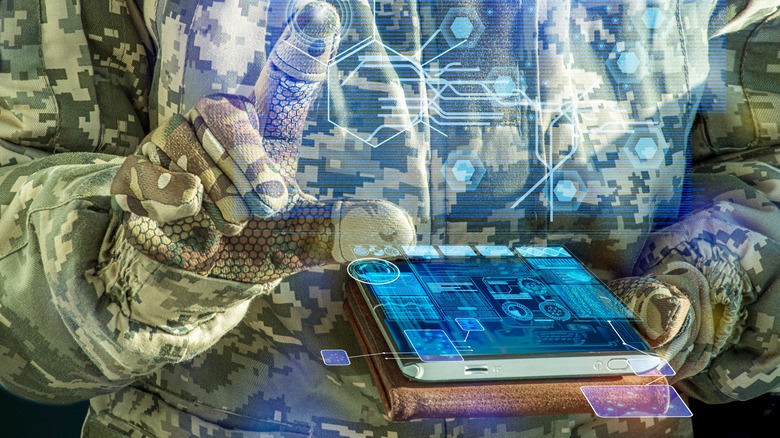Everything We Know About Israel's New Robotic Drone Tank (And Why It's Raising Concerns)
For the longest time, Israel has been at the forefront of military innovation and has been investing heavily in artificial intelligence (AI)-powered weapons more and more each year. With a commitment to becoming an AI superpower, the Israel Ministry of Defense has been consistently pushing the boundaries of emerging technology by creating dedicated organizations for it and ramping up its budget for research and development. Because of this, it's unsurprising that they'd reveal an unmanned robotic drone tank with cutting-edge technology.
In a 2022 press release, the Israel Ministry of Defense (MOD) announced its plans to begin testing a medium-sized, robotic combat vehicle (MRCV), called the Robotic Autonomous Sense and Strike (ROBUST). Launched at the Eurosatory Defence and Security Exhibition, the ROBUST M-RCV was developed by the Israeli MOD and the Israeli security industries, which included Elbit Systems, Foresight, and the Israeli defense company BL.
In the release, the Israel MOD states that the ROBUST M-RCV aims for operational effectiveness, simplicity, minimum operator intervention, and unmanned fleet integration. In line with its autonomous battlefield concept, the uncrewed ground vehicle (UGV) also combines advanced robotics technology with AI systems. Here's how it works and why it raises a few concerns.
What we know about the ROBUST M-RCV
According to Army Technology, the ROBUST M-RCV combines advanced AI capabilities with design details for multi-terrain, all-weather conditions, and passive thermal and visual sensors. It also includes a capsule drone, which offers 360-degree situational awareness of the battleground.
Fitted with a 30mm autonomous turret, which was developed by the Tank and APC Directorate, the turret was initially designed for the Eitan Armored Personnel Carrier (APC). A first-of-its-kind, the heavy-wheeled, all-terrain personnel carrier was not only built to transport soldiers and withstand mines and improvised explosive devices (IEDs) but also had high firepower capabilities. Aside from being remotely controlled, the turret is armed with a 12.7mm heavy machine gun and a pintle-mounted 7.62mm machine gun.
In addition, the Israel Aerospace Industries (IAI) and Rafael Advanced Defense Systems also contributed a missile launcher and Spike fire-and-forget anti-tank guided missiles (ATGMs) to the ROBUST M-RCV. The combat vehicle also uses Elbit's Iron Fist active protection system (APS), and fire control and mission management systems.
Although tanks and autonomous weapons have been part of military warfare for years, the ROBUST M-RCV is remarkable in that it integrates the use of AI heavily. Using an edge AI-powered driving module, the virtual driver makes use of 3D visualization and sensors to plan its movement and detect obstacles instantaneously. More importantly, it relies on automatic target recognition, auto-tracking for multiple targets, smart firing plans, and context-based target prioritization.
What makes Israel's new AI robotic drone tank concerning
Undoubtedly, the usage of artificial intelligence in battlegrounds has been growing steadily with time. From tech giants like Google assisting the US Department of Defence in spotting objects in drone footage to the Ukrainian military using AI-powered turrets to revolutionize trench warfare, it's becoming increasingly clear that AI can turn the tide in times of crisis.
However, there are plenty of valid reasons why AI-powered tanks can be concerning. For example, many critics are raising the alarm about its increasing vulnerability to hacking or sabotage. With military groups all over the world employing hackers, it's not far off to think that a single cybersecurity breach would compromise an entire fleet in one go.
Another is that an increased dependence on AI technology could potentially lead to operators becoming dependent on its systems. In many ways, operators and their ability to dissect nuanced situations are crucial to the de-escalation of risks and reduction of casualties. In addition, there are plenty of ethical implications to leaving algorithms to decide how they prioritize who gets to live or die, especially because technology isn't worried about turning evil.
The future of AI-powered weapons
A big question mark when it comes to the future of AI-powered weapons is how it is trained. Depending on the data sets it is trained on, AI-powered target recognition, threat assessment, and target locking can be heavily affected by bias and discrimination in terms of race, age, or gender. For example, a study revealed how an internet-trained AI had a tendency to exhibit racist and sexist tendencies in 2022. In addition, the use of AI, especially in tandem with other forms of cyber warfare, opens a can of worms in terms of international relations. With little to no rules regarding AI warfare, many countries ahead of the AI curve are faced with constantly changing regulations that evolve as technological advancements are brought to light.
In July 2020, NATO Secretary General Jens Stoltenberg introduced NATO's response to the growing threat of emerging technology on the battlefield: the Advisory Group on Emerging and Disruptive Technologies (EDTs). Composed of experts from both the private sector and academia, the group has helped lead the charge for developing policies and programs around emerging tech within their domains. In a 2021 Council in Foreign Relations blog, Megan M. Roberts, the director of policy planning at the United Nations Foundation, also shared that the UN Security Council's first debate on emerging technologies exposed the ongoing divisions between countries on their stances on digital policy, the effect of the wealth gap on the AI arms race, and scoping the possible harm involved.



